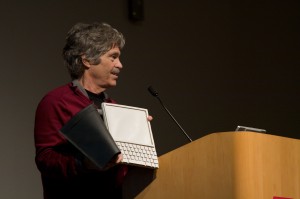Computer tablets became a big deal in 2010, but they weren’t anything new to Alan Kay. From “Space Wars: Fanatic Life and Symbolic Death Among the Computer Bums,” Stewart Brand’s 1972 Rolling Stone article about the emerging computer culture:
“Alan is designing a hand-held stand-alone interactive-graphic computer (about the size, shape and diversity of a Whole Earth Catalog, electric) called ‘Dynabook.’ It’s mostly high-resolution display screen, with a keyboard on the lower third and various cassette- loading slots, optional hook-up plugs, etc. His colleague Bill English describes the fantasy. thus:
‘It stores a couple of million characters of text and does all the text handling for you – editing, viewing, scanning, things of that nature. It’ll have a graphics capability which’ll let you make sketches, make drawings. Alan wants to incorporate music in it so you can use it for composing. It has the Smalltalk language capability which lets people program their own things very easily. We want to interface them with a tinker-toy kind of thing. And of course it plays Spacewar.’

"If Xerox Corporation decides to go with the concept, the Dynabooks could be available in two or three years."
The drawing capability is a program that Kay designed called ‘Paintbrush.’ Working with a stylus on the display screen, you reach up and select a shape of brush, then move the brush over and pick up a shade of half-tone-screen you like, then paint with it. If you make a mistake, paint it out with ‘white.’ The screen simultaneously displays the image you’re working on and a one-third reduction of it, where the dot pattern becomes a shaded half-tone.
A Dynabook could link up with other Dynabooks, with library facilities, with the telephone, and it could go and hide where a child hides. Alan is determined to keep the cost below $500 so that school systems could provide Dynabooks free out of their textbook budgets. If Xerox Corporation decides to go with the concept, the Dynabooks could be available in two or three years, but that’s up to Product Development, not Alan or the Research Center. Peter Deutsch comments: ‘Processors and memories are getting smaller and cheaper. Five years ago the idea of the Dynabook would have been a absolutely ridiculous. Now it merely seems difficult….'”

